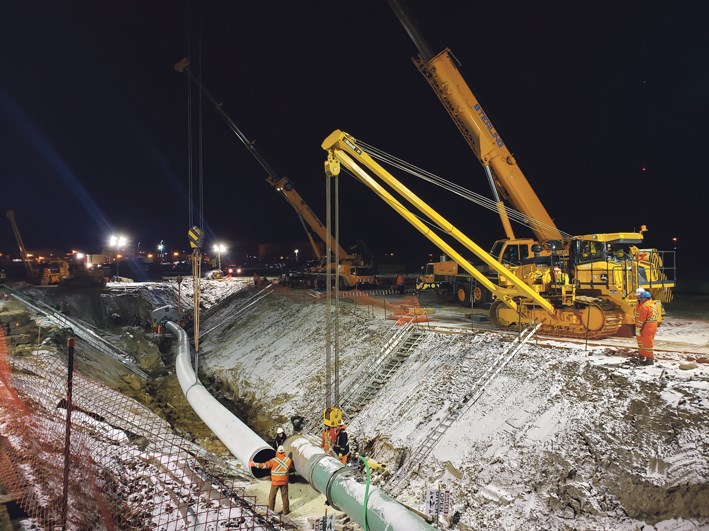It takes a community to build a pipeline.
Landowners, municipalities, First Nations and Métis people, regulators, elected officials, construction contractors, unions and chambers of commerce, goods and services providers, customers seeking to ship their products to market safely and reliably – it’s taken support from all of these groups to get the Enbridge Line 3 replacement pipeline (L3RP) built in Canada.
So says Leo Golden, Vice President, Line 3 Project Execution, as the new, 36-inch-diameter, Canadian-made pipeline is being put into service for the first time in December.
“We are truly grateful and humbled by the tremendous support we’ve received across Alberta, Saskatchewan and Manitoba for this project over these past six years,” says Golden. “Without that support and collaborative mindset, we wouldn’t be where we are today.”
The new pipeline will run at approximately half of its rated capacity, some 400,000 barrels per day, until such time as the Minnesota portion receives final approval, is constructed and brought onstream.
“First and foremost, the Line 3 project was about enhancing the safety and integrity of infrastructure critical to the functioning of our society, much like a highway, a bridge, or an airport,” Golden says. “Today, Line 3 is one of more than 80 oil and gas pipelines and 30 major electric transmission lines that cross the Canada-U.S. border, operating as part of a single, integrated North American energy market. Access to this continental energy market is critical for consumers, industry, and governments. “
The new pipeline stretches approximately 1,070 km from Hardisty, Alta. to Gretna, Man. At an estimated cost of $5.3 billion, it represents the largest capital expenditure – and the largest and most successful stakeholder engagement undertaking – in Enbridge’s 70-year history in Western Canada.
First announced in July 2013, Enbridge has since recorded more than 30,000 engagement activities with interested parties, including thousands of in-person meetings, presentations, coffee talks, group workshops, open houses and trade shows.In addition, project land agents have thus far conducted more than 31,000 landowner outreaches, garnering the support of all 1,087 right-of-way landowners along with 4,000 outreaches to 41 rural municipalities.
“We’ve worked very hard to listen and identify issues of concern,” Golden says. “Most importantly, we made meaningful changes to address those issues. The input we’ve received has truly helped make the L3RP better.”
One of the key components in earning support for any large industrial project in Canada today, he says, is seeking the active inclusion and participation of Indigenous communities. Recognizing this reality at the outset of the L3RP led to Indigenous labor and contracting spending in excess of $450 million.
“Businesses have a big role to play along the path to reconciliation and this includes an obligation to provide economic opportunities to Indigenous communities associated with Enbridge’s projects and activities,” says Golden. “Large projects like Line 3 are one way we can help lift Indigenous communities from poverty and toward future prosperity.
“When Indigenous communities benefit, we all do as Canadians.”
Among other highlights of this progressive approach, Enbridge:
- Ensured more than 300 contractors received cultural awareness training before setting foot on the project right-of-way;
- Secured cooperative agreements with almost 100 Indigenous communities or groups with provisions for Traditional Land Use, procurement, training and employment, environmental stewardship and construction monitoring;
- Trained over 300 men and women in the basic skills of pipelining, heavy equipment operation and pipeline inspection;
- Employed more than 1,100 Indigenous men and women, representing about 20 per cent of the construction workforce and a total of 141 communities; and,
- Paid wages of more than $120 million to Indigenous workers, supporting themselves, their families, and their communities.
Another defining characteristic of the L3RP was the focus on project community investment, which saw donations totaling some $3 million to support more than 400 community driven projects including celebrations/cultural events, building improvements, parks and playgrounds, environment and safety initiatives, emergency response equipment upgrades, and investments related to education, special projects and social issues.
These project funds are part of Enbridge’s ongoing community investment program, which in 2018 distributed more than $22.5 million to more than 3,450 organizations across North America.
Meanwhile, as the new pipeline begins to ship oil for its customers, final reclamation of the remaining 100 km of the construction area, in southeast Saskatchewan, will have to wait until the spring of 2020 due to inclement fall weather.
“Our objective, as always, is to restore the land to as good or better condition as prior to construction,”says Al Sawatzky, Line 3 Construction Manager.
Reflecting on the L3RP coming into service, Sawatzky says, “This is the only major pipeline construction in Canada in the last 10 years. Other major pipelines are planned, but none have started and we’ve been talking about them for several years now. So to build a major pipeline from Hardisty to the U.S. border is a pretty big deal –for Enbridge, for the industry, and for Canada.”
That just doesn’t happen, he adds, without the support of landowners, municipalities and Indigenous communities right across the Prairies.
“The railroads opened up this country. They were built to get things moving,” he concludes. “A pipeline is very similar – we have to get our product to market and pipelines are the safest way to do it.”




